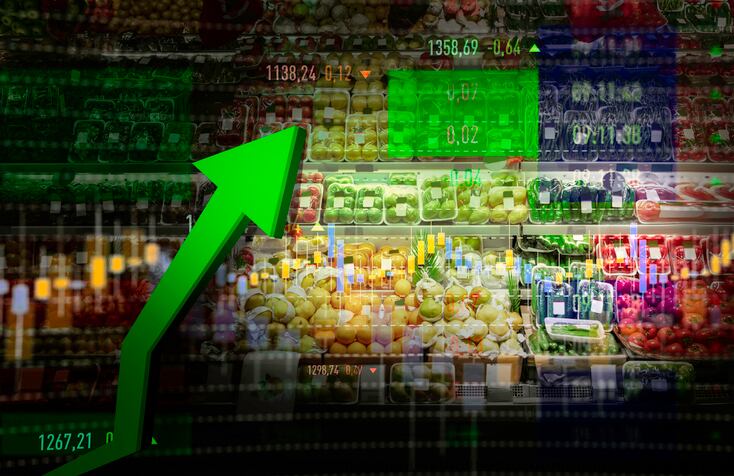According to new data released yesterday by USDA’s Economic Research Service, the price of food consumed at home is now expected to increase between 2.5 and 3.5% and food consumed away from home is expected to increase 3.4 to 4.5% in 2021 over 2020. The agency predicts this trend will continue in the coming year with at-home prices climbing an additional 1.5 to 2.5% and away-from-home prices increasing between 3 and 4%.
This is on top of dramatic increases last year compared to pre-pandemic levels. In 2020, the price of food consumed at home increased 3.5% compared to only 0.9% in 2019 before the coronavirus outbreak. Last year, food-away-from-home climbed 3.4%, according to USDA.
The brunt of the price increases in 2020 was led by meat with beef and veal climbing 9.6% year-over-year, pork up 6.3%, and poultry 5.6%. This was followed by a 4.4% increase in dairy prices and a 4.3% increase in eggs, according to ERS.
So far in 2021, the largest relative increases in the consumer price index were in fresh fruit, up 4.9%, and the smallest was in fresh vegetables, up only 0.4% -- but dramatic increases in the producer price index suggest that meat prices will continue to climb in the future.
Rising commodity prices predict future retail increases
Indeed, the Producer Price Index, which measures the average price domestic producers pay and can predict what may soon happen in the CPI, is predicted to increase across categories, according to ERS.
Yesterday, USDA raised PPI forecasts for wholesale meat in the teens to low 20s – reflecting high feed costs, increased demand and changes in the supply chain. The farm level price of dairy is now projected to fall several percentage points less than previously forecast.
Specifically, ERS predicts wholesale beef prices will increase between 14 and 17%, pork prices will climb 18 to 21% -- a slight downward adjustment from a previously predicted 19-22% increase – and wholesale poultry prices will increase 19-22% -- again slightly lower than an early 20 to 23% projected increase.
The slight decline in still high increases for pork and poultry reflect falling demand from China as it recovers from an outbreak of African Swine Fever in 2019, and a price drop in boneless, skinless chicken breasts, according to USDA.
Overall though, the higher commodity meat prices reflect tighter supply relative to current demand due in large part to fallout from the pandemic, Christine McCracken, executive director and protein analyst at Rabobank, told FoodNavigator-USA.
“Supplies have fallen short of expectations due to changes in production made during the pandemic given heightened uncertainty, while at the same time demand has far outstripped expectations due to higher disposable incomes and a swift recover in foodservice,” she explained.
She added that the sharp increase in underlying commodity prices “always makes its way to the store shelf, but typically on a one to three month lag.”
So, for example, she noted, “commodity chicken breast prices are up 61% YOY, yet retail prices are up only 9% versus year-ago, and they will likely continue to move higher until retailers can recoup some of the underlying cost.”
She also noted that a surge in retail costs, including labor and marketing costs, will also contribute to prices at shelf.
‘As government support fades and/or meat prices rise, consumption will likely drop’
In the near future, the rising cost of meat likely will not deter consumers, as meat tends to be fairly inelastic, predicts McCracken. However, she cautioned, a reduction in government benefits could impact sales in the future.
“Much of the recent increase in protein demand reflects a rise in disposable income and higher savings rates, which has enabled many consumers to buy more protein than they had historically,” she explained. But, she added: “As government support fades and/or meat prices rise, consumption will likely drop until the market reaches a new equilibrium.”
Animal protein companies can take advantage of higher consumer interest and defend against a potential sales drop by learning more about consumers and educating them about different cuts and proteins and teaching them how to maximize their use, McCracken advised.
“The consumer has shown that given the opportunity they will by more protein and are willing to try new and different products. With a shift to more in-home preparation this has been a good opportunity to educate the consumer on proper cooking techniques to eliminate some of the hurdles the industry has faced in the past,” she explained.
She added: “Consumers are also telling us they are willing to experiment and have more time to prepare meals, which is also creating new growth opportunities for the industry.”
Finally, she noted, companies can protect against sales attrition as prices rise by showing consumers how to get the most out of their investment.
“As prices move higher, it is also a great opportunity to talk about eliminating food waste and how to make use of leftovers or random ingredients,” she explained.
Price increases beyond meat
Meat is far from the only category expected to experience price increases.
USDA also predicts in 2021 that consumer prices for fish and seafood will increase 3 to 4%, dairy prices will climb 1 to 2%, fats and oils 3 to 4% and sugar and sweets 2 to 3%.
In addition, whole sale prices for wheat flour are predicted to climb 11 to 14%, according to ERS.




